Discover 35 hidden attractions, cool sights, and unusual things to do in Salvador (Brazil). Don't miss out on these must-see attractions: Museum of Modern Art of Bahia, Igreja do Bonfim, and Fort of Monserrate. Also, be sure to include Museu da Misericórdia in your itinerary.
Below, you can find the list of the most amazing places you should visit in Salvador (Bahia).
Table of Contents
Museum of Modern Art of Bahia
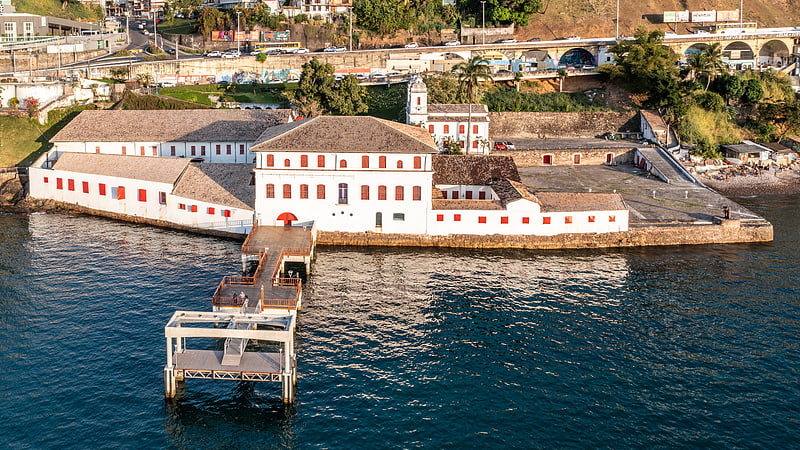
The Museum of Modern Art of Bahia is a modern art museum located in Salvador, Bahia, Brazil. It is located within Solar do Unhão, a historical site dating to the 16th century, on the margin of the Bay of All Saints. The museum was founded in 1960 under the architect Lina Bo Bardi and initially located in the foyer of the Castro Alves Theater; it moved to its present location in 1963. MAM-BA is one of twelve state museums linked to the Institute of Artistic and Cultural Heritage, an authority of the Department of Culture of the State of Bahia.
The collection of MAM-BA is noted for paintings, sculptures, photographs, and drawings by artists such as Tarsila do Amaral, Portinari, Flávio de Carvalho, Di Cavalcanti, Rubem Valentim, Pancetti, Carybé, Mário Cravo Neto, and Sante Scaldaferri. MAM-BA has eight exhibition rooms; a theater; a library; a technical space to house conservation, restoration, and museology; and an art workshop that offers open courses of painting, engraving techniques, ceramics, drawing, handmade paper, and sculpture to the community.[1]
Address: Av. Contôrno, s/n, 40301-155 Salvador (Centro)
Igreja do Bonfim

Also known as: Igreja Nosso Senhor do Bonfim
Famed 18th-century Catholic church. The Church of Nosso Senhor do Bonfim is the most famous of the Catholic churches of Salvador, in the State of Bahia, Brazil. It was built in the 18th century on the only line of hills in the Itapagipe Peninsula, in the lower town of Salvador. The church is the subject of intense religious devotion by the people of Salvador and is the site of a famous celebration held every year in January, the Festa do Senhor do Bonfim. The church is the Cathedral of the Roman Catholic Diocese of Bonfim. The church is noted for the Festa do Bonfim, held annually the second Thursday after Three Kings Day. The festival combines elements of both Catholicism and Candomblé. It was listed as a historic structure by the National Historic and Artistic Heritage Institute in 1938.[2]
Address: Largo do Bonfim, s/n, 40415-475 Salvador (Itapagipe)
Fort of Monserrate
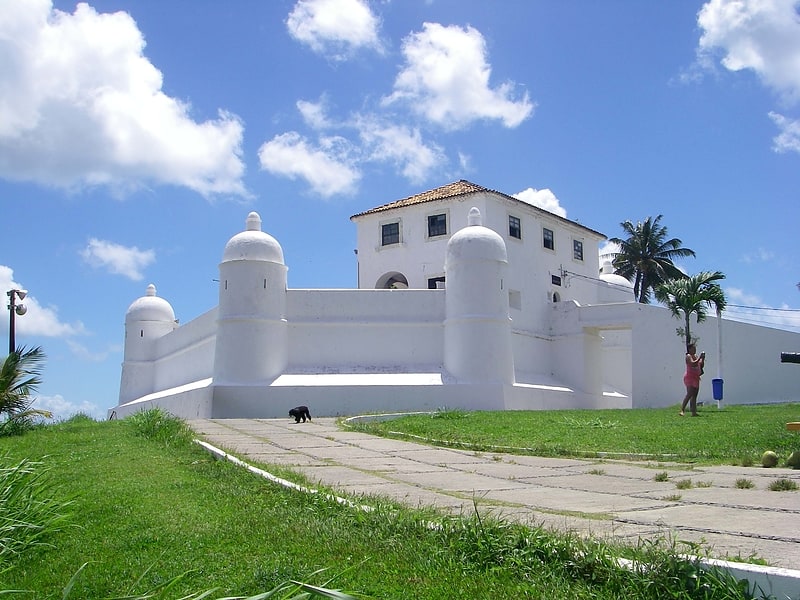
The Fort of Monserrate is a military fortification located in Salvador, Bahia in Brazil. It is also known as the Small Fort of Our Lady of Monserrate. It was known as the Forte de São Felipe from the time of its construction until the 19th century. The Fort of Monserrate was built between the end of the 16th century and early 17th century on the Itapagipe Peninsula. It is "one of the few Brazilian fortifications to retain its original appearance from the late 16th century." The fort is located above the Church and Monastery of Our Lady of Monserrate, one of the oldest church structures in Brazil. The fort was listed as a historic structure by the National Institute of Historic and Artistic Heritage in 1938.[3]
Address: R. da Boa Viagem, 471-593, 40414-610 Salvador (Itapagipe)
Museu da Misericórdia
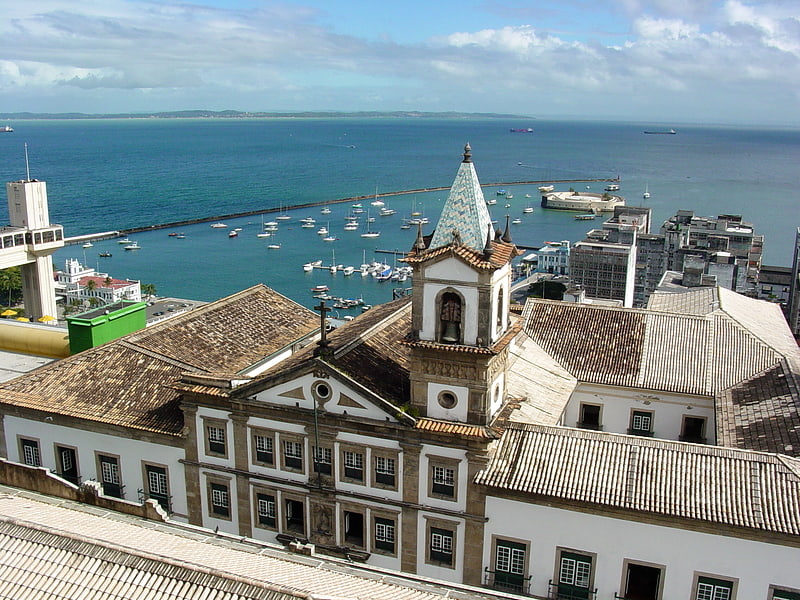
The Church and Santa Casa da Misericórdia is a former church and hospital in Salvador, Bahia, Brazil. It was established as a branch of the Santa Casa da Misericórdia in 1549; a hospital, Hospital da Caridade, functioned from the 17th century. The Santa Casa additionally held a monopoly on burials in colonial Bahia. It was additionally funded by its brotherhood, the Brotherhood of Santa Casa. The Santa Casa of Bahia accepted the donation of a slave-holding plantation, the Fazenda Saubara in present-day Saubara, in 1652. The former hospital and chapel now functions as a museum, the Misericórdia Museum. The Santa Casa, apart from the museum, now owns and operates the Santa Izabel Hospital, the Santa Casa Medical Faculty, the Jorge Calmon Memory Center, Campo Santo Cemetery, an events space, and numerous historic buildings in Salvador.[4]
Address: 6 Rua da Misericórdia, Salvador (Centro)
Forte de São Marcelo
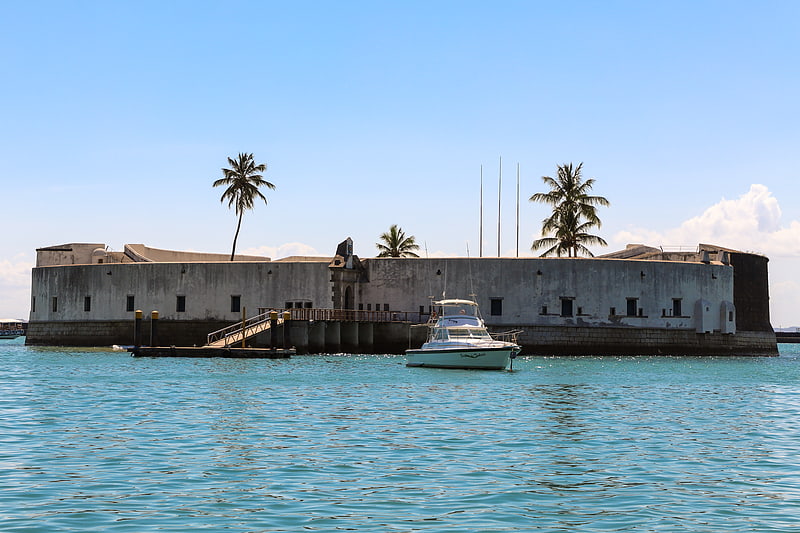
São Marcelo Fort, also known as Forte de Nossa Senhora do Pópulo e São Marcelo or Forte do Mar, is located in Salvador in Bahia, Brazil. It is located in small bit of land off the coast in the Baía de Todos os Santos. Standing on a small bank of reefs about 300 metres from the coast, it is one of two forts separated by water from land in Brazil, the other being the Fort Tamandaré da Laje Tamandaré in Rio de Janeiro. It is the only cylindrical fort in Brazil. Its design follows those of Castel Sant'Angelo in Italy and São Lourenço do Bugio Fort in Portugal. It is popularly known as the "Forte do Mar". It was built to protect the important port city Salvador from threats; the city had the largest number of forts during the colonial period of Brazil.[5]
Church and Monastery of Our Lady of Monserrate
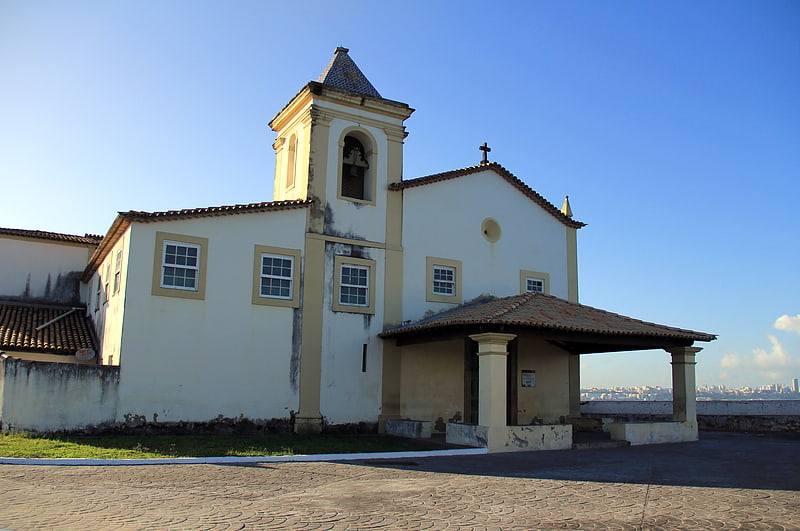
The Church and Monastery of Our Lady of Monserrate is a 16th-century Roman Catholic church and monastery located in Salvador, Bahia, Brazil. The church and monastery are dedicated to Our Lady of Monserrate and belongs to the Roman Catholic Archdiocese of São Salvador da Bahia. It is located 200 metres from the Fort of Monserrate on a rock on the Itapagipe Peninsula. The date of construction of the structure is disputed; it dates to the 16th century, and has seen numerous alterations. The church was built either by the Spanish, or by the group that constructed the Garcia d'Ávila Tower House. Its design, along with that of numerous rural chapels of Bahia, is attributed to the Italian architect Baccio da Filicaia. The church interior was once lined entirely with 16th-century azulejos; now only a single strip of the tiles remain. The church was listed as a historic structure by the National Historic and Artistic Heritage Institute in 1958. It and the Chapel of Our Lady of the Ladder are the only remaining 16th-century chapels in Salvador.[6]
Igreja de São Domingos de Gusmão
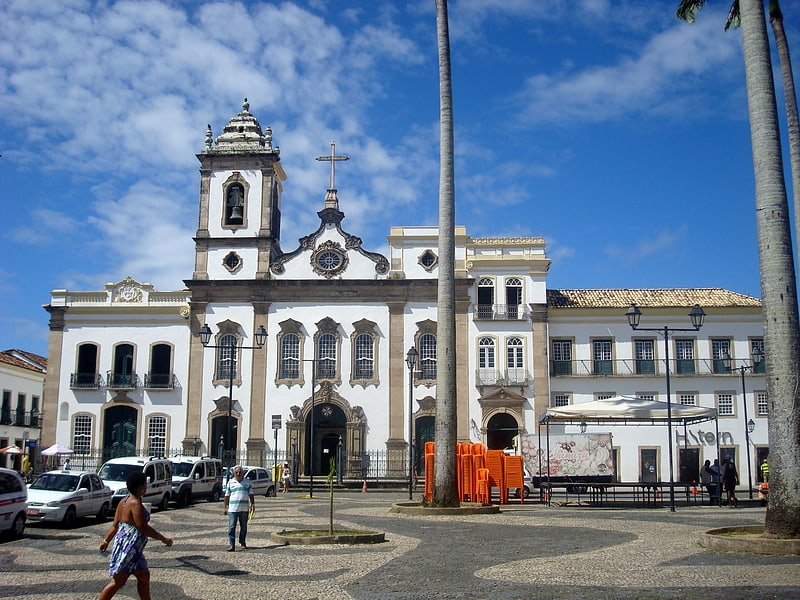
The Church of the Third Order of Penitence of Saint Dominic of Osma is an 18th-century Roman Catholic church in Salvador, Bahia, Brazil. The church is dedicated to Saint Dominic, a Castilian priest and founder of the Dominican Order. It belongs to the Roman Catholic Archdiocese of São Salvador da Bahia. It occupies the north-west perimeter of the Terreiro de Jesus, opposite the Cathedral Basilica of Salvador. The church was listed as a historic structure by the National Historic and Artistic Heritage Institute in 1938.[7]
Rio Branco Palace
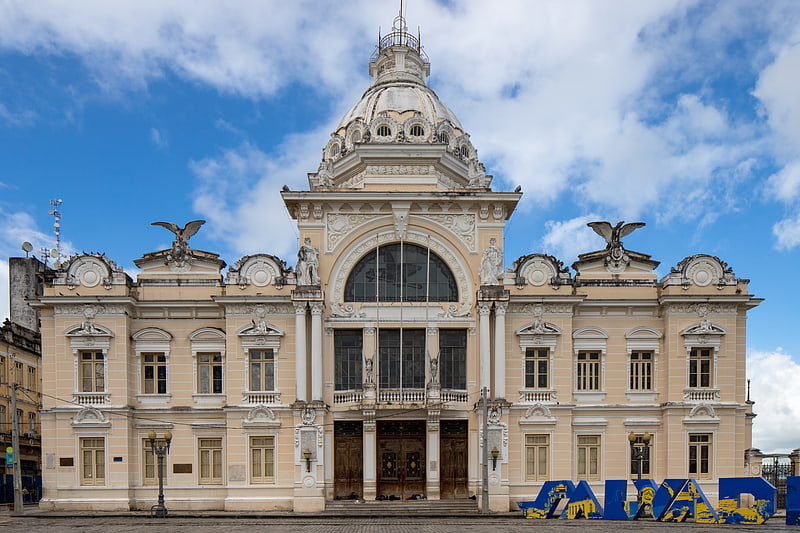
Also known as: Palácio Rio Branco
History museum in Salvador, Brazil. The Rio Branco Palace is a palace and former seat of government in Salvador, Bahia, Brazil. It is one of the oldest palaces in Brazil and dates to 1549. It is located within the UNESCO World Heritage Site of the Historic Center of Salvador.[8]
Address: Praça Tomé de Souza - S/N, 40020-000 Salvador (Centro)
Parish Church of Our Lady of Pilar
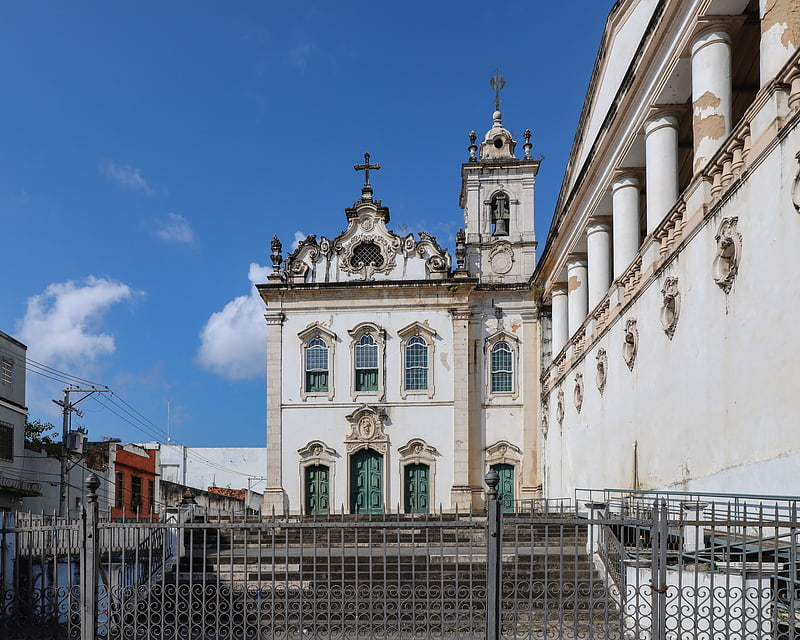
The Parish Church of Our Lady of Pilar is an 18th-century Roman Catholic church located in Salvador, Bahia, Brazil. It includes a cemetery, constructed in the Neoclassical parallel to the nave of the church. The interior of the church has an extensive set of azulejo tiles in the rococo style. The historian Carlos Ott dated them to the late 18th century, and stated that they appear to be the work of the Juncal workshop in Portugal. The stonework of the church is in lioz stone, imported from Lisbon at great expense. The art historian Germain Bazin describes the church as a "refinement of forms", due to its long, narrow nave and lack of corridors in the nave.
The church closed in 1994 after heavy rains caused the collapse of a wall of the church; additionally, the cemetery was used by residents for waste disposal. A restoration project began in 2011, which included the removal of 2,500 tons of garbage from the cemetery. The Parish Church of Our Lady of Pilar reopened in 2015.[9]
The British Cemetery
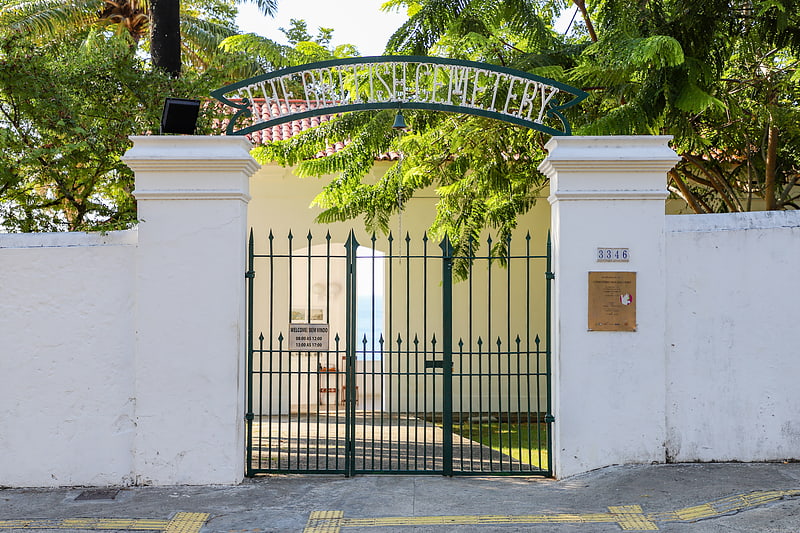
Burial ground. The British Cemetery of Bahia is a burial ground located in Salvador, the capital and largest city in the Brazilian state of Bahia. Its history dates back to the Navigation and Trade Treaty, also known as the Strangford Treaty, signed by the Kingdom of Portugal and the United Kingdom of Great Britain and Ireland in 1810. The treated permitted the establishment of churches of the Church of England in Brazil, then a colony of Portugal. Built in 1814 and located in Avenida Sete de Setembro, more specifically Ladeira da Barra, it is the principal heritage site of the British community in Bahia. The British Cemetery was classified a state landmark by the Institute of Artistic and Cultural Heritage of Bahia in 1993.[10]
Address: 3345 Avenida Sete de Setembro, Salvador (Barra)
Cathedral of Salvador

Also known as: Catedral Basílica Primacial São Salvador
Ornate 17th-century Mannerist church. The Cathedral Basilica of Salvador, officially dedicated to the Transfiguration of Christ and named Primatial Cathedral Basilica of the Transfiguration of the Lord is the seat of the Archbishop of the city of Salvador, in the State of Bahia, in Brazil. The Archbishop of Salvador is also ex officio Primate of Brazil. The structure was built by the Society of Jesus as part of a large Jesuit monastic and educational complex. The current church is the built on the site, and was consecrated in 1654. After the expulsion of the Jesuits from Brazil in 1759 the school and church were transferred to the Archbishopric of Bahia. Archbishop Augusto Álvaro da Silva ordered the demolition of the existing cathedral of Salvador in 1933 to construct a tram line, and elevated the existing Jesuit structure to the status of basilica.
The cathedral is considered one of the finest examples of Mannerism in the Portuguese empire and strongly resembles the Jesuit Church of Coimbra. The façade and other elements of the structure utiltize Lioz stone from Portugal. The interior of the cathedral has a large nave, elaborate baroque-style side altars, a sacristy, library, and ossuary.
The Cathedral Basilica of Salvador faces a broad plaza, the Terreiro de Jesus; is flanked by the broad Praça da Sé to the south, and overlooks the Bay of All Saints to the rear. It is a focal point of the Historic Center of Salvador, a UNESCO World Heritage Site.[11]
Address: Terreiro De Jesus, 40.000-000 Salvador das Missoes (Centro)
Basilica of the Immaculate Conception

Also known as: Basílica Nossa Senhora da Conceição da Praia
Basilica in Salvador, Brazil. The Basilica of the Immaculate Conception, or the Basilica of the Conception, is a church in Salvador, Bahia, Brazil. It is affiliated with the Catholic Church and was built in 1623, making it one of the oldest parishes in the Roman Catholic Archdiocese of São Salvador da Bahia. It was the first church built by the first governor-general of Brazil, Tomé de Sousa. The current structure was prefabricated in Portugal and assembled in Salvador; its construction began in 1739 and ended in the mid 19th century. The art historian Germain Bazin classifies the church as Portuguese in design, rather than part of the Bahian tradition of religious structures of the 17th and 18th century.
Its monumental façade is a hybrid of Baroque and Neoclassical styles, and is based on church façades of the period in Portugal. The building was designed by Manuel Cardoso Saldanha; the master bricklayer and architect Eugénio da Mota prepared the stonework in Portugal and accompanied it to Salvador. Its elevation to the status of basilica took place in 1946. Pope Pius XII declared Our Lady of Conception the sole patron of the State of Bahia. Robert C. Smith described the structure as the "first and most complete expression in Brazil of the new Baroque style that succeeded Mannerism in Portugal in the early years of John V's reign." The Portuguese art historian João Miguel dos Santos Simões stated that "Among the remarkable examples of 18th-century architecture that the Portuguese built on Brazilian soil, this one, honoring the patron saint of the Kingdom, stands out in historical importance and majesty."[12]
Address: Rua da Conceição da Praia, S/N, 40015-250 Salvador (Centro)
Barradão

Also known as: Estádio Manoel Barradas
Multi-purpose stadium in Salvador, Brazil. Estádio Manoel Barradas, is a multi-purpose stadium in Salvador, Brazil. It is currently used mostly for football matches. The stadium has a current maximum capacity of 34,535 spectators. The stadium was built in 1986 and reinaugurated in 1991.
The Barradão is owned by Esporte Clube Vitória. The stadium is named after Manoel Barradas, who was a Vitória's counselor.[13]
Address: Rua Artemio Castro Valente 1, 41260-300 Salvador (Pau da Lima)
Pestana Convento do Carmo

The Church and Convent of Our Lady of Mount Carmel is a 17th-century Roman Catholic church and former convent in Salvador, Bahia, Brazil. The church is dedicated to Our Lady of Mount Carmel. The complex is adjacent to the Church of the Third Order of Mount Carmel. The Church and Convent of Our Lady of Mount Carmel was listed as a historic structure by National Institute of Historic and Artistic Heritage in 1938 and is part of the Historic Center of Salvador UNESCO World Heritage Site.[14]
Metrô Lapa

The Church and Convent of Our Lady of the Conception of Lapa (Portuguese: Igreja e Convento de Nossa Senhora da Conceição da Lapa is an 18th-century Roman Catholic church located in Salvador, Bahia, Brazil. The church is dedicated to Our Lady of Lapa and is part of the Roman Catholic Archdiocese of São Salvador da Bahia. It is known as key site in the Brazilian independence movement in the early 19th century. Sister Joana Angélica resisted the invasion of Portuguese troops into the convent and was killed by bayonet in 1822 at the south portal of the convent.
The interior of the church is noted as "one of the finest rococo compositions in the city". Its original baroque construction of the 18th century remains largely unaltered, with a complex high altar, azulejos in the chancel, and a well-preserved nave ceiling painting. The Church and Convent of Our Lady of the Conception of Lapa was listed as a historic structure by the National Historic and Artistic Heritage Institute (IPHAN) in 1938.[15]
Address: Avenida Joana Angélica, Salvador (Centro)
Chapel of the Holy Body
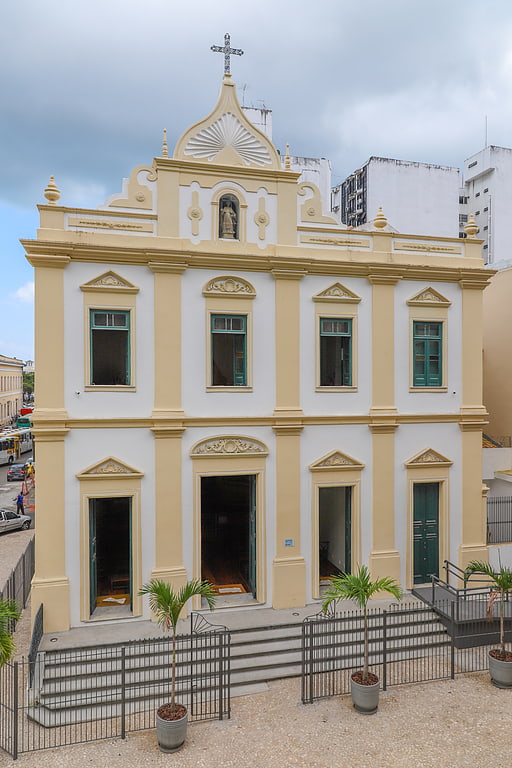
The Chapel of the Holy Body is an 18th-century Roman Catholic church in Salvador, Bahia, Brazil. The church is dedicated to Saint Peter González; Saint Joseph is also venerated by the congregation. It belongs to the Roman Catholic Archdiocese of São Salvador da Bahia. The church is the seat of the Brotherhood de São José do Corpo Santo, which also manages the property. A large scale image of Our Father of Salvation attributed to Francisco das Chagas is located in the church.[16]
Itaipava Arena Fonte Nova
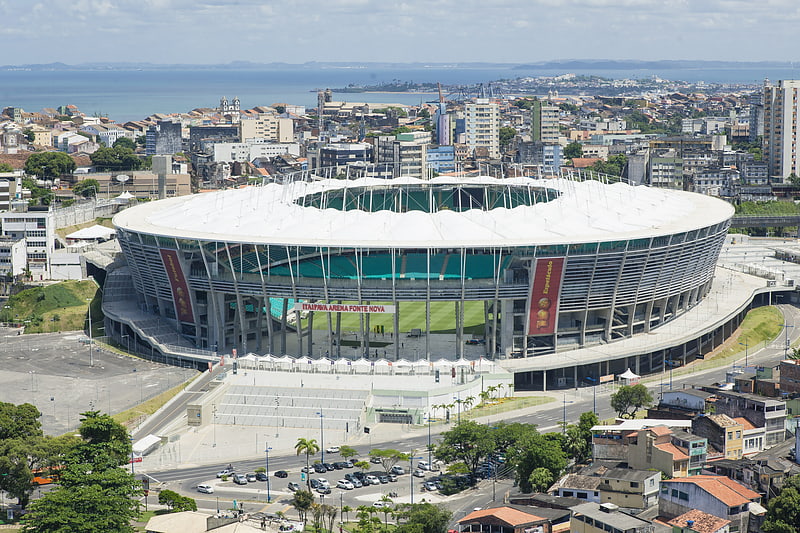
Also known as: Arena Fonte Nova
Arena in Salvador, Brazil. The Itaipava Arena Fonte Nova, also known as Complexo Esportivo Cultural Professor Octávio Mangabeira, is a football-specific stadium located in Salvador, Bahia, Brazil, and has a maximum capacity of 48,000 people. The stadium was built in place of the older Estádio Fonte Nova.
The stadium was first used for the 2013 FIFA Confederations Cup and the subsequent 2014 FIFA World Cup, including the 5–1 win of The Netherlands over reigning World Champions Spain. It was used as one of the venues for the football competition of the 2016 Summer Olympics.
A group of architects from Brunswick, Germany, which also redesigned the old Hanover stadium into a modern arena for the 2006 Cup, was selected after bidding. Since 2013, the brewery Itaipava from Grupo Petrópolis has the naming rights of the arena "Itaipava Arena Fonte Nova" under a sponsorship agreement until the year 2023, amounting to $100m. This was the first naming rights agreement signed for the 2014 World Cup stadiums.
The stadium was inaugurated on April 7, 2013, with a Campeonato Baiano game in which Vitória defeated Bahia 5–1. The first player to score a goal in the stadium was Vitória's Renato Cajá. During this match, some supporters were unable to see the game completely due to some blind spots. The stadium had excessive dust and some puddles. The company responsible for the stadium, owned by Grupo OAS and Odebrecht, said it was aware of the problems.
On May 27, 2013 a section of the roof collapsed after heavy rain.[17]
Address: Ladeira da Fonte das Pedras, 40050-565 Salvador (Centro)
Church and Convent of São Francisco
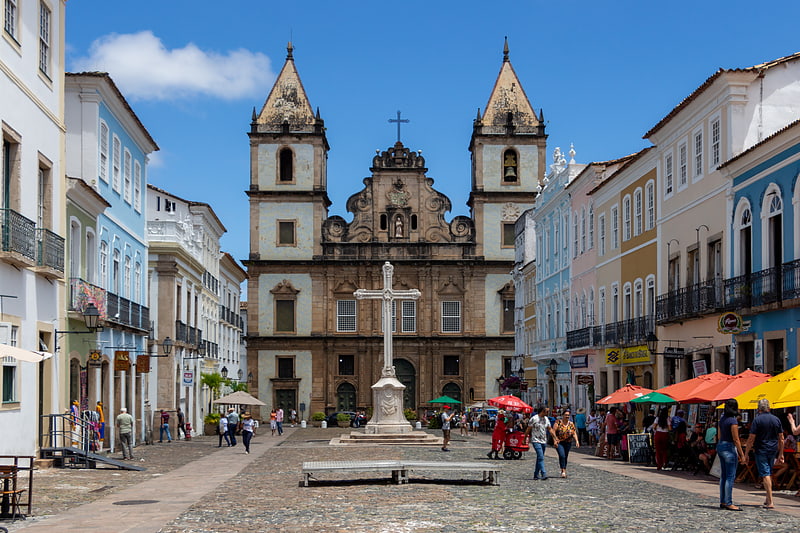
Also known as: Igreja e Convento de São Francisco
Lavishly decorated 18th-century church. The São Francisco Church and Convent of Salvador is located in the historical centre of Salvador, in the State of Bahia, Brazil. The ornate Church of the Third Order of Saint Francis sits adjacent to the convent. The friars of the Franciscan Order arrived in Salvador in 1587 and constructed a convent and church on the site. This structure was destroyed by the Dutch during the Dutch invasions of Bahia in the next century; Father Vicente das Chagas initiated the current structure in 1686, which was completed in the 18th century. The Franciscan church and convent have the largest number of azulejos, 55,000, of any church in Latin America.
The convent and its church are important colonial monuments in Brazil. It was listed as a historic structure by the National Institute of Historic and Artistic Heritage in 1938. The convent, church, and Church of the Third Order are one of the Seven Wonders of Portuguese Origin in the World and form integral parts of the UNESCO World Heritage Site Historic Center of Salvador.[18]
Address: Largo do Cruzeiro de São Francisco, S/N, 40020-280 Salvador (Centro)
Forte de Santo Antônio da Barra
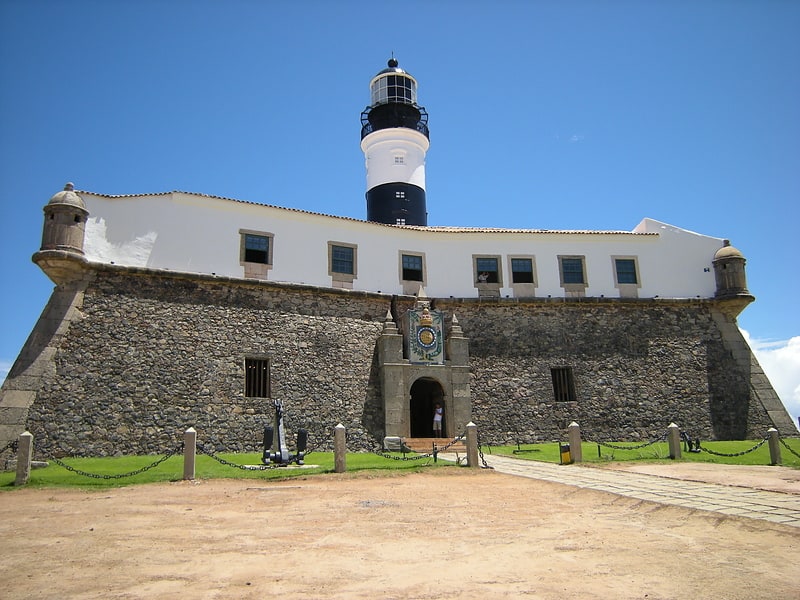
Forte de Santo Antônio da Barra is a fort located in Salvador, Bahia, Brazil. It was constructed to guard the entrance to the Bay of All Saints, during the time of the Portuguese Empire. The first Portuguese fortification erected in Bahia was likely built in 1501, on the same area now occupied by the Forte de Santo Antônio da Barra. The foundation stone of that first fortification was placed in an area called Ponta do Padrão, now known as the Largo do Farol da Barra, the broad public square in front of the fort. The fort also houses the 22 metres -high Barra Lighthouse and the Nautical Museum of Bahia. The Santo Antônio da Barra Fort is protected as a historic structures by the National Institute of Historic and Artistic Heritage.[19]
Church of Saint Antony of Barra

The Church of Saint Antony of Barra is a 17th-century Roman Catholic church in Salvador, Bahia, Brazil. It is one of three churches in Salvador dedicated to Saint Anthony of Padua and belongs to the Roman Catholic Archdiocese of São Salvador da Bahia. The church was likely founded in the 17th century on a point overlooking the Bay of All Saints. It features a simple Renaissance-style façade, nave, chancel, sacristy, and other rooms.[20]
Teatro Vila Velha

Cultural center in Salvador, Brazil. The Vila Velha Theater, also known simply as "Vila", is a performing arts center in Salvador, Bahia, Brazil. The theater was constructed in 1964 and is located on Avenida Sete, at the west of the 19th-century Neoclassical public area, the Passeio Público.
The Vila Velha Theater is based in the Teatro dos Novos Society (Portuguese: Sociedade Teatro dos Novos, STN), the first professional theater group dating to the 1950s. The group was led by João Augusto de Azevedo (1928-1979), a professor at the Federal University of Bahia. A group of dissident students, which consisted of Echio Reis, Sônia Robatto, Carlos Petrovich, Othon Bastos, Thereza Sá, and Carmem Bittencourt, led the creation of a permanent theater. The state government of Bahia granted a space in the Public Promenade in 1961 for the construction of the new theater. The premiere show of the theater was title Nós, Por Exemplo ("We, For Example") included Caetano Veloso, Gilberto Gil, Tom Ze, Gal Costa, and Maria Bethânia.
The theater was a center of the 1960s counterculture movement, Tropicália, and cultural opposition to the Military dictatorship in Brazil (1964-1985). Vila hosted social protest events in the 1970s. The theater entered into a period of decline with the death of João Augusto in 1979. A revitalization of the theater began in 1994 under the Sol Movimento da Cena, a non-profit organization. A large-scale renovation of the theater building followed in 1998.[21]
Address: Av. Sete de Setembro, s/n - Passeio Público - Campo Grande - Salvador - Bahia - Brasil, Salvador (Centro)
Igreja da Ordem Terceira de São Francisco
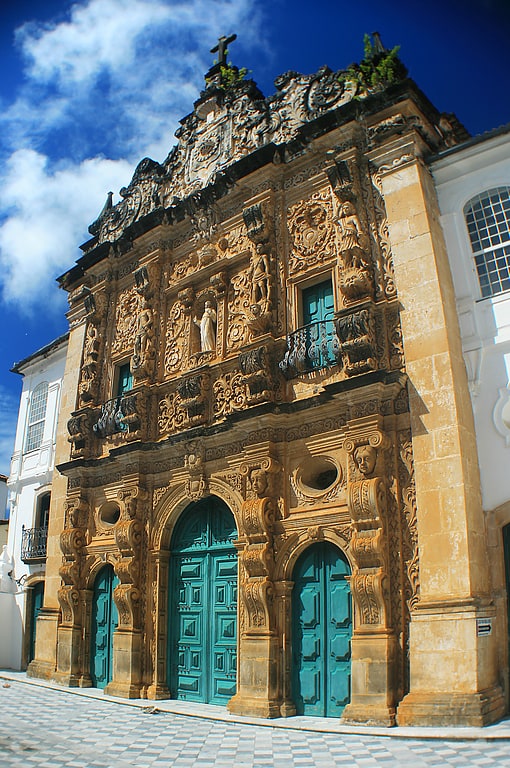
The Church of the Third Order of Saint Francis is an 18th-century Roman Catholic church in Salvador, Bahia, Brazil and seat of the Third Order of Saint Francis in Brazil. The church is one of the main elements of the Historic Center of Salvador and lies within the UNESCO World Heritage Site of the city. It was listed as a historic structure by National Institute of Historic and Artistic Heritage in 1941. The church was constructed as an annex to the São Francisco Church and Convent. It is noted for its distinctive Plateresque-style façade, an example unique in Brazil. The writer Jorge Amado called the façade of the Third Order church "magnificent."[22]
Address: Rua da Ordem Terceira, 40026-260 Salvador (Centro)
Church and Convent of Our Lady of the Exile
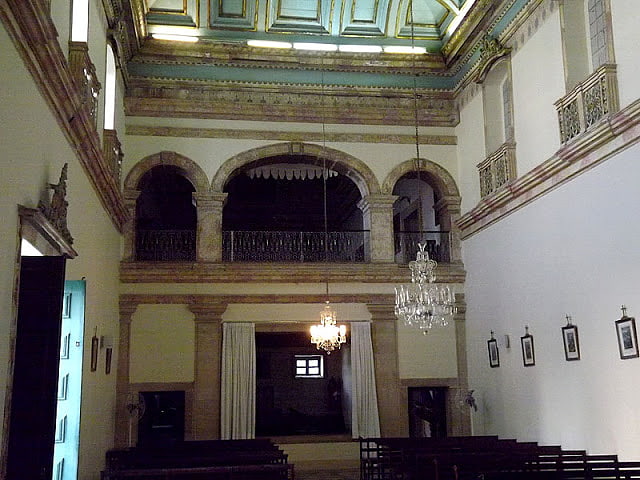
The Church and Convent of Our Lady of the Exile is a 17th-century Roman Catholic church located in Salvador, Bahia, Brazil. The Convent of Our Lady of the Exile was the first female convent constructed in Brazil. Construction of the convent began in 1681 due to the donation of a large fortune of Dona Antônia de Góis, a member of the order. The church building is noted for its elaborate portal in the Rococo style. Its belvedere was the first in Salvador, followed by that of the Convent of Lapa. The high altar has images of Saint Clare, the founder of the order, and Saint Francis; they date to the mid-18th century. The interior of the church was largely renovated in the Neoclassical style in the 19th century. The church was listed as a historic structure by the National Historic and Artistic Heritage Institute in 1938.[23]
Chapel of Saint Lazarus

The Chapel of Saint Lazarus is an 18th-century Roman Catholic church located in Salvador, Bahia, Brazil. The chapel is dedicated to Saint Lazarus and Saint Roch. The chapel was established as a hermitage to treat people with leprosy; it was later used as a quarantine station for enslaved people arriving from Africa. Worship at the chapel is syncretic in character, with its two annual festivals combining Roman Catholic and Candomblé elements. The chapel is located on a hill high in the Federação neighborhood and consists of a single nave, altar, gallery, and sacristy. It is listed as a historic structure by the Instituto do Património Artístico e Cultural da Bahia.[24]
Church of Our Lady of Health and Glory
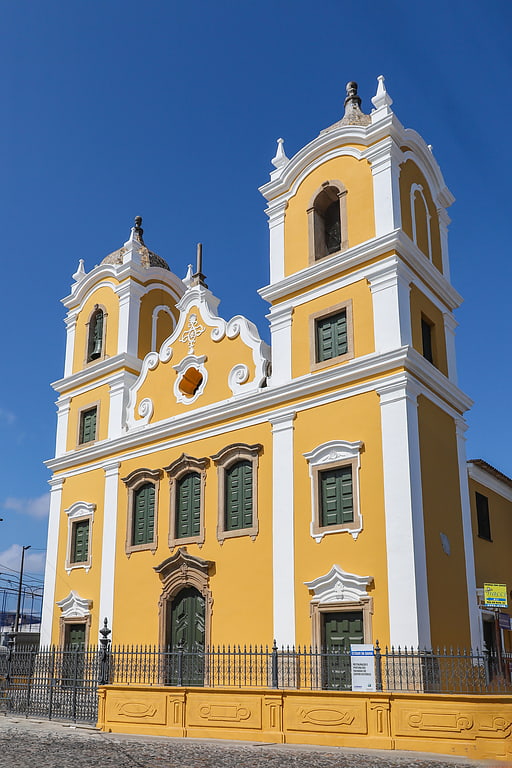
The Church of Our Lady of Health and Glory is an 18th-century Roman Catholic church located in Salvador, Bahia, Brazil. The church is dedicated to Our Lady of Health. It was constructed by Manuel Ramos Parente and his wife Maria de Almeida Reis on the second line of hills below the Historic Center of Salvador in the 18th century. The first mass was celebrated in 1726, the same year that Parente died. The church is noted for the painting on the ceiling of the nave by Domingos da Costa Filgueira, the first in Bahia. The interior of the church was slowly completed into the 19th century; it now has neoclassical interior elements and an elaborate Baroque and rococo façade. Its two towers have elaborately tiled tops.[25]
Forte de Santa Maria
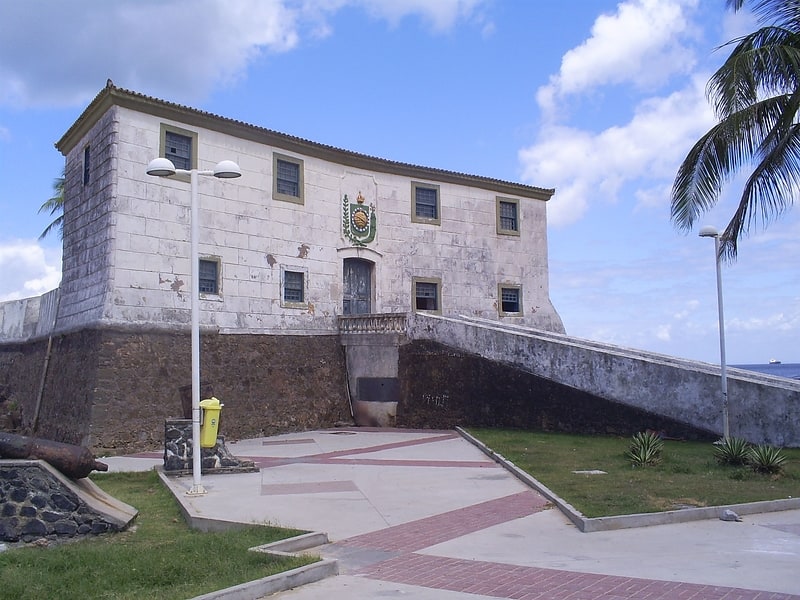
Forte de Santa Maria is a fort located in Salvador, Bahia in Brazil. It is also known as the Fortim de Santa Maria. It retains much of its original structure of the 17th century, including its broad, stone curtain walls. The fort is in the shape of a heptagon and is accessed via a narrow embankment. The fort was listed as a historic structure by the National Institute of Historic and Artistic Heritage in 1938. It is closed to the public, is not maintained by federal or state institutions and is falling into a state of disrepair.[26]
Church and Convent of Our Lady of Solitude
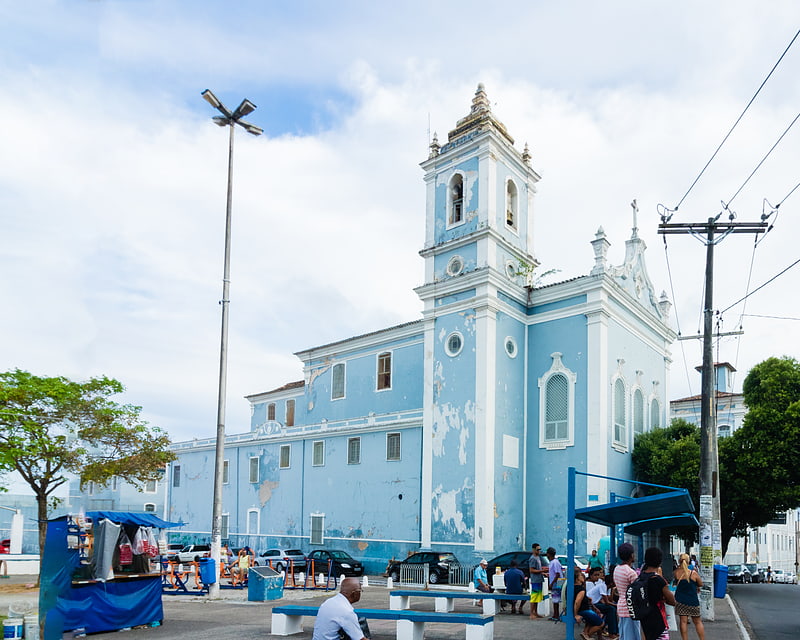
The Church and Convent of Our Lady of Solitude is an 18th-century Roman Catholic church and former convent in Salvador, Bahia, Brazil. The church and convent were founded in 1736 and are dedicated to Our Lady of Solitude. The convent has functioned as a school since 1927. The Church and Convent of Our Lady of Solitude is located within the Protected Historic District of Soledade by the State of Bahia.[27]
São Paulo da Gamboa Battery
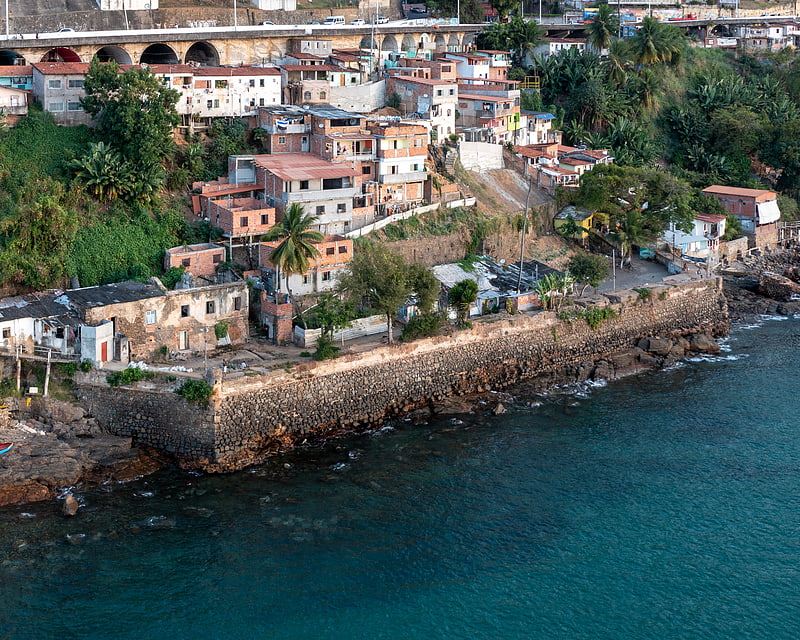
Fortress in Salvador, Brazil. The São Paulo da Gamboa Battery is a military fortification located in Salvador, Bahia in Brazil. It is also known as the Fort of São Paulo da Gambôa, or simply the Fort of Gambôa. The battery was built in the early 17th century as part of a series of military fortifications in Salvador by Jean Massé, a French military engineer. The battery was built as an extension of the Fort of Saint Peter; it functioned to defend the city against Dutch and French attacks. The battery was listed as a historic structure by the National Institute of Historic and Artistic Heritage in 1938. Despite its listing as a federal historic structure, it is not under the care of any public agency or institution. The battery is in an advanced state of disrepair, occupied by informal settlements, and is below a slope prone to landslides.[28]
Church of the Third Order of the Holy Trinity
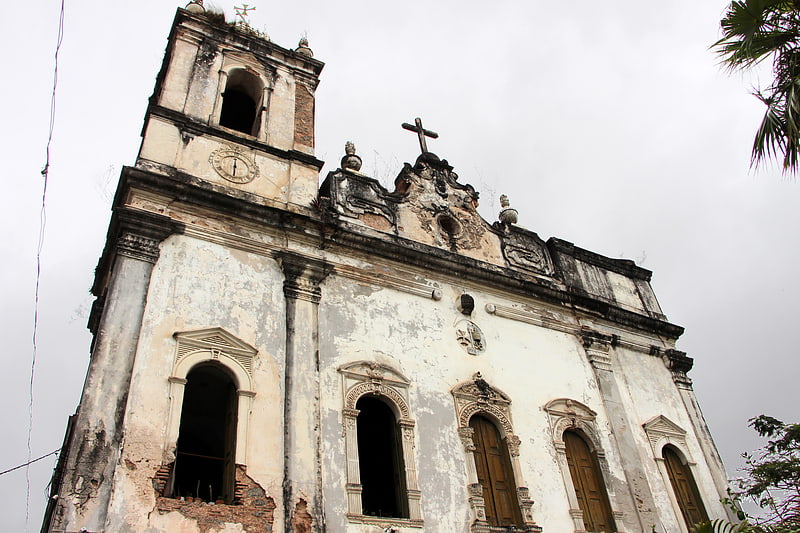
The Church of the Third Order of the Holy Trinity is an abandoned Roman Catholic church located in Salvador, capital of the Brazilian state of Bahia. First built as a chapel in 1733 and later expanded into its current structure in 1739, the church was abandoned by the Archdiocese of São Salvador in 1990. Located in the decadent Água de Meninos neighbourhood, the church was abandoned for a whole decade until it was reclaimed by a group of homeless people known as the Trinity community in 2000.[29]
Church of the Blessed Sacrament of Saint Anne

The Church of the Blessed Sacrament of Saint Anne is an 18th-century Roman Catholic church located in Nazaré, Salvador, Bahia, Brazil. The church is dedicated to Saint Anne and belongs to the Roman Catholic Archdiocese of São Salvador da Bahia. Its construction began in 1747 and continued over the next two decades. The church sits on the second line of hills below the Historic Center of Salvador in the neighborhood of Nazaré. It was built on a hill above the Gravatá Fountain, which likely dates to the early 18th century. The church has a single nave with no side chapels; the side aisles are surmounted by tribunes. The transept features a cupola with a skylight, a feature unique in Bahia. The rear of the church has an ossuary constructed around a small courtyard. The church was listed as a historic structure by the National Historic and Artistic Heritage Institute in 1941.[30]
Igreja do Boqueirão

Convent. The Church of the Third Order of the Blessed Virgin Mary of Our Lady of the Conception of the Mulatto Brothers is an 18th-century Roman Catholic church and former convent in Salvador, Bahia, Brazil. The church was constructed in a neighborhood formerly occupied by mixed-race and Afro-Brazilian artisans. The exterior of the church has an elaborate roccoco pediment and towers; the interior of the church has a Baroque-style ceiling painting in the nave and neoclassical side altars and chancel. The name of the church, boqueirão, refers to a large slope and trench constructed between the high city and low city of Salvador; it served as a defense of the city against foreign invasion. It was listed as a historic structure by the National Historic and Artistic Heritage Institute in 1951.[31]
Chapel of Our Lady of the Ladder
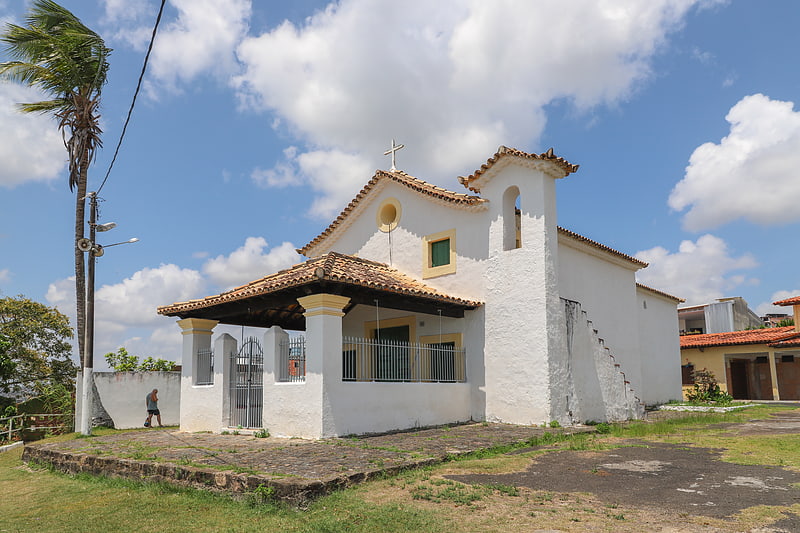
The Chapel of Our Lady of the Ladder is a 16th-century Roman Catholic church located in Salvador, Bahia, Brazil. It was constructed as part of the Nossa Senhora de Escada sugar plantation by Lázaro Arévolo, likely in 1566; he donated the chapel to the Jesuits in the late 16th century. The chapel is part of the Roman Catholic Archdiocese of São Salvador da Bahia; it was listed as a historic structure by the National Institute of Historic and Artistic Heritage in 1962. It and the Church and Monastery of Our Lady of Monserrate are the only remaining 16th-century chapels in Salvador.[32]
Queimado Fountain
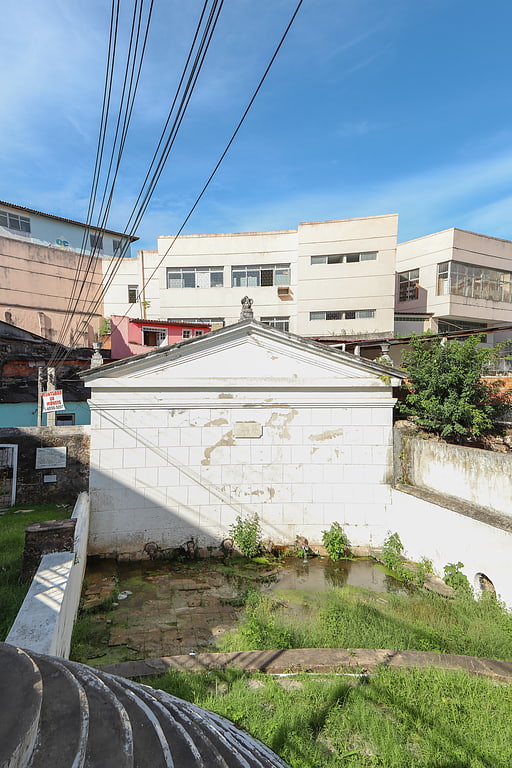
Fountain in Salvador, Brazil. The Queimado Fountain is an abandoned fountain in Salvador, Bahia, Brazil. The fountain is located at the Largo do Queimado, a broad public square, below the Church and Convent of Our Lady of Solitude. The fountain likely dates to the early 19th century and is one of a series of fountains built along the escarpment of the historical center of Salvador. It consists of a broad brick area and glazed tile facade with a triangular pediment. The fountain was listed as a historic structure by the Artistic and Cultural Heritage Institute of Bahia in 1984.[33]
Forte de São Diogo
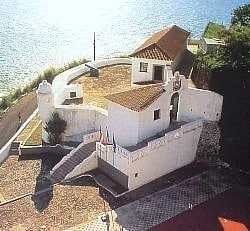
Tourist attraction in Brazil. Forte de São Diogo is a fort located in Salvador, Bahia Brazil.[34]
Address: Rua do Forte de Sao Diogo s/n, 40130-170 Salvador (Barra)
Caramuru Building

The Caramuru Building is an office building in Salvador, Bahia, Brazil. It was designed by the architect Paulo Antunes Ribeiro for Prudência Capitalização, an insurance company. Construction began on the structure in 1946 and it opened in 1951. The Caramuru Building was one of the first Modernist building constructed in the Northeast Region of Brazil, closely following the construction of Hotel de Bahia. It was widely recognized by the domestic and international architectural press; it was described as having a "graceful, almost abstract elegance contrasted with the robust architecture of Bahia." The structure fell into disrepair but remains in the Comércio district. It is a protected structure by the state of Bahia and has provisional protected status by the by National Institute of Historic and Artistic Heritage.[35]